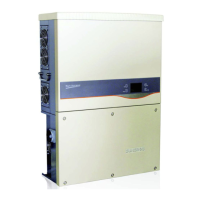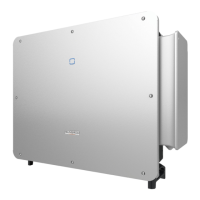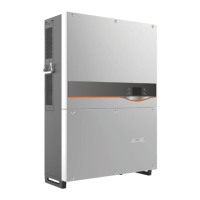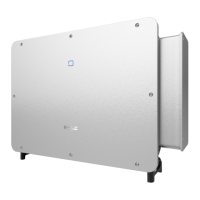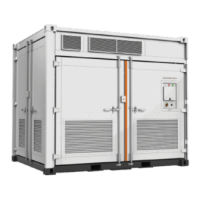22
• If the inverter is installed in a place with lush vegetation, weed on a regular basis. In addi-
tion, the ground beneath the inverter needs to undergo certain treatment, such as laying
cement or gravel, etc. (an area of 3m×2.5m is recommended).
• Do not install the inverter in an environment with flammables, explosives, or smoke.
• Do not install the inverter in places prone to water leak, e.g., under the air-conditioner
vent, the air vent, or the cable outlet window of the machine room, so as to prevent de-
vice damage or short circuit caused by intrusion of water.
• Do no install the inverter in a place with corrosives such as corrosive gas and organic
solvent, etc.
• When the inverter is running, its surface may carry high voltages or get very hot. Do not
touch it; otherwise, it may lead to burns or electric shocks.
• Do not install the inverter in a place that is easy to reach for people.
• Install the inverter in a place with shelter, so as to prevent it from getting impacted by di-
rect sunlight and severe weather (e.g. snow, rain, and lightning). The inverter will derate
in high temperatures for self-protection. If installed in a place directly exposed to sunlight,
as the temperature rises, the inverter may witness power reduction.
• Good heat dissipation is very important to the inverter. Please install the inverter in a ven-
tilated environment.
• If the inverter needs to be installed in a closed environment, please install additional heat
dissipation or ventilation devices. During the running of the inverter, the room tempera-
ture should not be higher than the outdoor ambient temperature.
• Please consult SUNGROW before installing inverters outdoors in areas prone to salt
damage, which mainly are coastal areas within 500 meters of the coast. The sedimenta-
tion amount of salt spray is correlated to the characteristics of the seawater, sea winds,
precipitation, air humidity, topography, and forest coverage in the adjacent sea areas,
and there are substantial differences between different coastal areas.
• Do not install the inverter in an environment contaminated with chemicals such as halo-
gen and sulfide.
• Do not install the inverter in an environment with vibration and strong electromagnetic
field. Strong-magnetic-field environments refer to places where magnetic field strength
measures over 30 A/m.
• In dusty environments such as places full of dust, smoke, or floc, particles may cling to
the device’s air outlet or heat sink, thus impacting its heat dissipation performance or
even getting it damaged. Therefore, do not install the inverter in dusty environments. If
the inverter has to be installed in such environments, please clean its fans and heat sink
on a regular basis to ensure a good heat dissipation performance.
• The inverter should be installed in a place over 30 m away from the third party wireless
communication facilities and environments for living.
• The average temperature approximately 1 m around the inverter should be taken as its
operating temperature. The temperature and humidity should meet the requirements
below:
4 Mechanical Mounting User Manual

